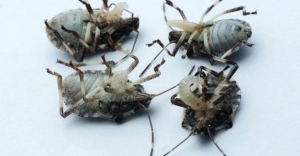
Small, white larvae (inset photo above) of the sand wasp, Bicyrtes quadrifasciata, feed on brown marmorated stinkbug nymphs. The sand wasps (at right) collect the nymphs, move them to their burrows, then lay eggs that hatch into larvae that feed on the nymphs.
Photos courtesy of David Biddinger
Pennsylvania State University’s Dr. David Biddinger is a veteran in the army battling for better biocontrol, and it’s had its ups and downs. But it has made him confident that patience and diligence can pay off.
Over the last ten years, he has been involved in the introduction of a new predatory mite, and it came about in an unusual way.
Pennsylvania had become known for a very successful integrated pest management program based on biological control of mites in apple orchards by the black lady beetle, Stethorus punctum, he said. It worked from about 1978 to 1998. Then, several new classes of insecticides toxic to Stethorus practically eliminated this predator from orchards.
But the replacement of one of the older very toxic carbamate insecticides (methomyl) with some of these new pesticides allowed the survival of a beneficial mite previously not known in Pennsylvania apple orchards. The new predatory mite, Typhlodromus pyri, was found in 2003 in orchards that were using only reduced-risk insecticides.
As it turned out, T. pyri is at least ten times more effective than Stethorus in reducing pest mite injury, he said. It was the perfect replacement.
The predatory mite was not widespread, so a program was set up to allow growers to make spring cuttings in “seed orchards” on the Penn State research station that had the mite and move them into their own orchards. Once there, they established quickly if not killed by harsh insecticides such as pyrethroids.
“Unlike other predatory mite species, T. pyri never leaves the tree, even when pest mite populations decline,” Biddinger said. “They are able to subsist on pollen, fungal spores, or nonharmful apple rust mites until the pest mites return.”
Biddinger would like to be so fortunate dealing with predators of brown marmorated stinkbug. He is surveying predators and parasites, and when he finds them, he determines which pesticides are detrimental to them and which food sources they need in order to survive and be available when the first stinkbugs arrive.
One key factor is on their side. Because the stinkbugs live outside orchards most of the time, in woodlots and other places where pesticides are not sprayed, much of the biological control fruit growers need can established in safe havens away from the orchards.

Leave A Comment